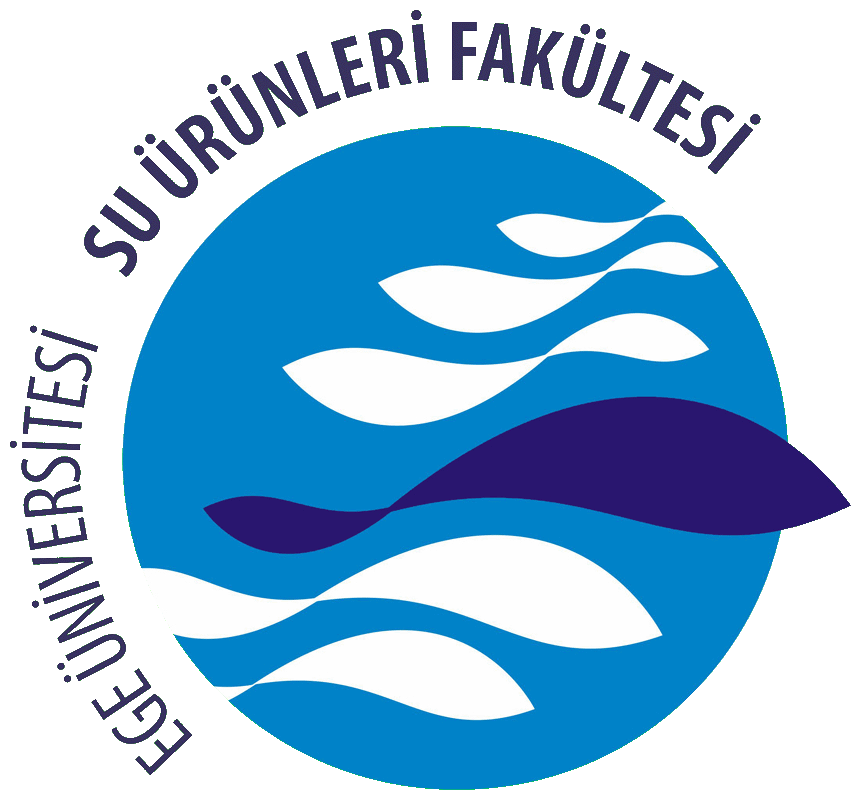(ESFM)
E.U. Faculty of Fisheries Scientific Material (ESFM) was officially established with the decision of the faculty board dated 19.03.2007. However, the creation of its materials started in 1965 with the establishment of the Marine Biology Research and Application Laboratory in Mektupçu (where DEU Devak Hotel is located today) under the leadership of Prof. Dr. Remzi Geldiay (1919-1989). Since then, individuals belonging to the species collected and identified during scientific expeditions in the inland waters and coasts of our country and Northern Cyprus have been taken under protection. In addition, species belonging to various groups donated to the Faculty from various parts of the world are also kept. Individuals belonging to the species identified within the scope of research activities have started to be given registration numbers. It is the first scientific material established for this purpose in our country and the wealth of material it contains is not available in any other institution in our country.
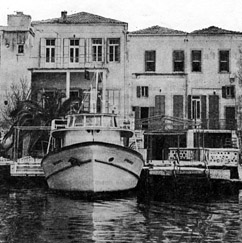
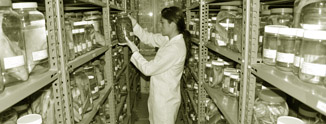
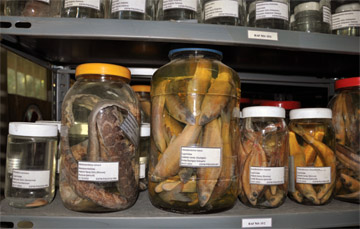
ESFM has been registered in the Registry of Biological Repositories run by the Smithsonian Institution since January 2010. In the museum, where the aquatic biodiversity of our country is recorded and permanently preserved, there are individuals belonging to various species collected from different regions of our country from 1930 to the present day. In the museum collection, there are also type individuals (Holotype, Paratype and Neotype) belonging to 31 species identified for the first time in the world by the faculty members of the faculty. 1 of these is a fish (Luciobarbus kottelati), the others are invertebrate species.
ESFM also contains individuals of approximately 4100 species, including 154 inland fish species, 120 marine fish species, 300 phytoplankton species, 50 sponge species, 1010 Annelida species, 900 Mollusca species, 1220 Arthropoda species and 300 other invertebrate species. In the Inland Fishes Section of ESFM, approximately 46000 individuals collected from various habitats in 26 river basins of our country are classified. Of the 236 inland fish species identified so far in our country, 154 (65% of the total fauna) are kept in the museum.
There are a large number of invertebrate species living in our seas. For example, 95% of Polychaeta species, 80% of Crustacea and Mollusca species identified on the coasts of our country are kept in the museum. Most of these individuals form the basis of various scientific researches and are used as comparison material. Some of the scientific material is also used as sample material in the laboratories of the courses taught at the Faculty of Fisheries. The main objective of ESFM is to preserve individuals of all species living in the waters of our country in accordance with international standards, to contribute to scientific studies, and to explain our biological richness and its importance to our students and the public.
So far, a total of 75 international articles have been produced using the scientific materials of the Faculty, 55 of which have been published in journals within the scope of Science Citation Index. In addition, the biological materials of the master's and doctoral theses carried out in the Department of Fisheries Basic Sciences at the E.U. Institute of Science and Technology are also stored in the museum. While the scientific materials were previously stored in 2 large rooms in the MÖTBE building, the materials are now stored in the basement under the Dean's Office of E.Ü. Faculty of Fisheries. It is thought that the importance of scientific materials in our country and in the world will increase if the appropriate physical environment and personnel are provided. The materials, which are currently used only for scientific studies, will be organized in an exhibition hall for visitors in the coming years.
For the material currently used only for scientific studies, an exhibition hall for visitors is planned in the future.
Address: Ege University Campus, Faculty of Fisheries, Department of Basic Sciences, 35100, Bornova, Izmir.
Phone/Fax: (0232) 311 17 34
E-mail: esfm@mail.ege.edu.tr
Principles to be Followed
1. ESFM (Ege University Faculty of Fisheries Scientific Material) aims to ensure the proper and permanent storage and preservation of individuals of species identified as a result of research activities at the faculty and individuals of species donated to the museum from outside the institution.
2. Buffered formol (4%) or 70% alcohol should be used for preservation of specimens. Individuals of hard-structured species such as corals, bivalves, echinoderms, etc. should be stored dried, if necessary.
3. Each specimen to be added to the material should be given a catalog number. Catalog numbers should be generated using computer programs and all catalog numbers should be printed on CDs and stored every 6 months. All information on the label of each species given a catalog number and the number of individuals of the species should be entered into the computer.
4. The catalog number consists of immutable and variable codes. The invariable code is ESFM, which stands for (Ege University Fisheries Faculty Scientific Material). The variable codes are the abbreviation of the systematic group name following the ESFM name (Table 1), sampling date and catalog entry number (Figure 1).
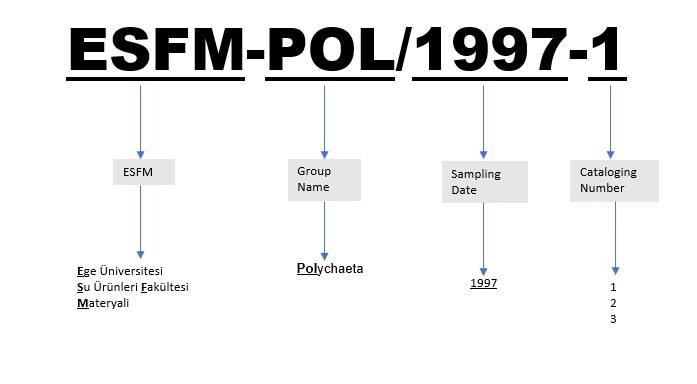
5. Each systematic group stored in ESFM will have a responsible investigator (Curator).
6. Catalog numbers will be assigned by the researchers responsible for the systematic groups.
7. The samples belonging to each group in the ESFM will be maintained by the responsible researchers.
8. On the label of each material transferred to the ESFM, "species name, date of sampling, name of the research site and station number (if available), habitat structure (including depth), names (initials and surname) of the people who made the sampling and identification" must be written. If possible, the coordinates of the stations where the samples were taken should also be written on the label. If the samples were collected as part of a research project, the code of the project (e.g. 03 BAP 005, Tubitak 104Y065, etc.) should be written in the "collected by" section (Figure 2). In addition, the date (month and year) of the species identification should be given in parentheses.
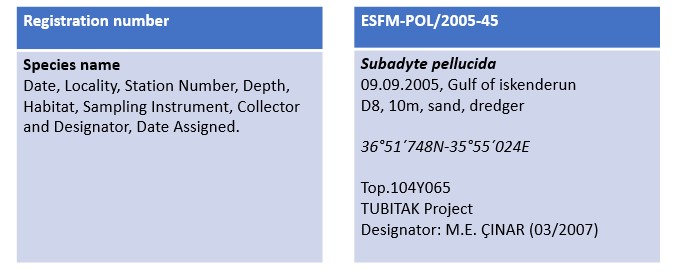
9. Articles, papers, etc. published as a result of systematic studies should include the name of the museum and the catalog number of the material. A copy (or electronic file) of published articles containing scientific materials should be sent to the systematic group responsible.
10. Researchers who wish to work with ESFM materials must obtain permission from the group supervisor.
11. Materials can be sent to researchers who request to borrow materials from ESFM. For this purpose, the attached Loan Request Form and Material Submission Form should be used. Those who wish to donate their collections or designated individuals to ESFM must complete and sign the attached Donation Form.
Petitions and Forms
Turkish |
English |
|
| Material Donation Form | Donation Form | |
| Material Submission Form | Invoice Form | |
| Material Request Form |
Loan Request Form |
Group Codes
| No. | Group Name | Code | RESPONCIPLE RESEARCHER | |
|---|---|---|---|---|
| 1 | ALGLER | ALG | Tufan KORAY | tufan.koray@ege.edu.tr |
| 2 | ALGLER (İÇ SULAR) | ALGI | ||
| 3 | AMPHIBIA | AMP | Ertan TAŞKAVAK | ertan.taskavak@ege.edu.tr |
| 4 | AVES | AVS | Ertan TAŞKAVAK | ertan.taskavak@ege.edu.tr |
| 5 | BIVALVIA (DENİZ) | BIV | Alper DOĞAN | alper.dogan@ege.edu.tr |
| 6 | BIVALVIA (İÇ SULAR) | BIVI | Murat ÖZBEK | murat.ozbek@ege.edu.tr |
| 7 | BRACHIOPODA | BRA | Bilal ÖZTÜRK | bilal.ozturk@ege.edu.tr |
| 8 | BRANCHIOPODA | BRN | Didem ÖZDEMİR | didem.ozdemirmis@ege.edu.tr |
| 9 | BRYOZOA | BRY | Melih Ertan ÇINAR | melih.cinar@ege.edu.tr |
| 10 | CAUDOFOVEATA | CAU | Bilal ÖZTÜRK | bilal.ozturk@ege.edu.tr |
| 11 | CEPHALOCHORDATA | CEC | Melih Ertan ÇINAR | melih.cinar@ege.edu.tr |
| 12 | CEPHALOPODA | CEP | Alp SALMAN | alp.salman@ege.edu.tr |
| 13 | CHAETOGNATHA | CHA | İsmet ÖZEL | ismet.ozel@ege.edu.tr |
| 14 | CIRRIPEDIA | CIR | Melih Ertan ÇINAR | melih.cinar@ege.edu.tr |
| 15 | CNIDARIA | CNI | Melih Ertan ÇINAR | melih.cinar@ege.edu.tr |
| 16 | COPEPODA (DENİZ) | COP | İsmet ÖZEL | ismet.ozel@ege.edu.tr |
| 17 | COPEPODA (İÇ SULAR) | COPI | Cem AYGEN | cem.aygen@ege.edu.tr |
| 18 | CTENOPHORA | CTE | İsmet ÖZEL | ismet.ozel@ege.edu.tr |
| 19 | ECHINODERMATA | ECH | Melih Ertan ÇINAR | melih.cinar@ege.edu.tr |
| 20 | ECHIURA | ECR | Melih Ertan ÇINAR | melih.cinar@ege.edu.tr |
| 21 | FANEROGAMLAR | PHA | Melih Ertan ÇINAR | melih.cinar@ege.edu.tr |
| 22 | FANEROGAMLAR (İÇ SULAR) | PHAI | ||
| 23 | GASTROPODA (DENİZ) | GAS | Bilal ÖZTÜRK | bilal.ozturk@ege.edu.tr |
| 24 | GASTROPODA (İÇ SULAR) | GASI | Murat ÖZBEK | murat.ozbek@ege.edu.tr |
| 25 | GASTROTRICHA | GAT | Didem ÖZDEMİR | didem.ozdemirmis@ege.edu.tr |
| 26 | HEMICHORDATA | HEC | Melih Ertan ÇINAR | melih.cinar@ege.edu.tr |
| 27 | HIRUDINEA | HIR | Murat ÖZBEK | murat.ozbek@ege.edu.tr |
| 28 | INSECTA | INS | Ayşe TAŞDEMİR | ayse.ozdemir@ege.edu.tr |
| 29 | MALACOSTRACA (DENİZ) | MAL | Tuncer KATAĞAN | tuncer.katagan@ege.edu.tr |
| 30 | MALACOSTRACA (İÇ SULAR) | MALI | Murat ÖZBEK | murat.ozbek@ege.edu.tr |
| 31 | MAMMALIA | MAM | Ertan TAŞKAVAK | ertan.taskavak@ege.edu.tr |
| 32 | MONOPLACHOPHORA | MNP | Bilal ÖZTÜRK | bilal.ozturk@ege.edu.tr |
| 33 | NEMATODA | NMT | Melih Ertan ÇINAR | melih.cinar@ege.edu.tr |
| 34 | NEMERTINI | NEM | Melih Ertan ÇINAR | melih.cinar@ege.edu.tr |
| 35 | OLIGOCHAETA | OLG | Seray YILDIZ | seray.yildiz@ege.edu.tr |
| 36 | OSTRACODA (DENİZ) | OST | İsmet ÖZEL | ismet.ozel@ege.edu.tr |
| 37 | OSTRACODA (İÇ SULAR) | OSTI | Cem AYGEN | cem.aygen@ege.edu.tr |
| 38 | PHORONIDA | PHO | Melih Ertan ÇINAR | melih.cinar@ege.edu.tr |
| 39 | PISCES (DENİZ) | PIS | Okan ÖZAYDIN | okan.ozaydin@ege.edu.tr |
| 40 | PISCES (İÇ SULAR) | PISI | Hasan Musa SARI | hasan.sari@ege.edu.tr |
| 41 | PLATYHELMINTHES | PLT | Melih Ertan ÇINAR | melih.cinar@ege.edu.tr |
| 42 | POLYCHAETA | POL | Melih Ertan ÇINAR | melih.cinar@ege.edu.tr |
| 43 | POLYPLACHOPHORA | PLP | Bilal ÖZTÜRK | bilal.ozturk@ege.edu.tr |
| 44 | PORIFERA | POR | Melih Ertan ÇINAR | melih.cinar@ege.edu.tr |
| 45 | PRIAPULIDA | PRI | Melih Ertan ÇINAR | melih.cinar@ege.edu.tr |
| 46 | PROTOZOA | PRO | Tufan KORAY | tufan.koray@ege.edu.tr |
| 47 | PYCNOGONIDA | PYC | Tuncer KATAĞAN | tuncer.katagan@ege.edu.tr |
| 48 | REPTILIA | REP | Ertan TAŞKAVAK | ertan.taskavak@ege.edu.tr |
| 49 | ROTIFERA | ROT | Didem ÖZDEMİR | didem.ozdemirmis@ege.edu.tr |
| 50 | SCAPHOPODA | SCP | Bilal ÖZTÜRK | bilal.ozturk@ege.edu.tr |
| 51 | SIPUNCULA | SIP | Melih Ertan ÇINAR | melih.cinar@ege.edu.tr |
| 52 | SOLENOGASTRES | SOL | Bilal ÖZTÜRK | bilal.ozturk@ege.edu.tr |
| 53 | TUNICATA | TUN | Melih Ertan ÇINAR | melih.cinar@ege.edu.tr |


